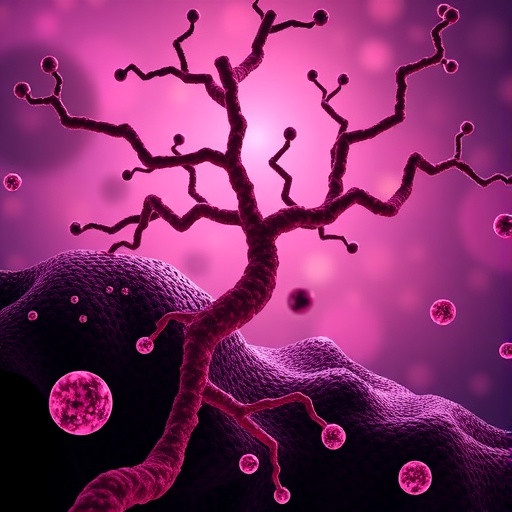In a groundbreaking advancement for biological sciences, researchers affiliated with the Earth-Life Science Institute (ELSI) at the Institute of Science Tokyo have unveiled a fundamental principle elucidating why organismal growth rates, contrary to expectations, decelerate as nutrient abundance increases—a phenomenon commonly known as the law of diminishing returns. This novel conceptual framework transcends traditional models by providing a comprehensive mathematical explanation rooted in the intrinsic complexities of cellular resource allocation.
The quest to decode the mechanics of growth across the tree of life has long preoccupied biologists. Growth is universally influenced by nutrient availability, energy supply, and cellular machinery capacities. Yet, prevailing investigations frequently isolate singular nutrients or biochemical pathways, leaving the interconnected network of cellular constraints largely unexplored. This oversight obscures the collective dynamics that genuinely govern growth under resource scarcity.
The research team, spearheaded by ELSI’s Associate Professor Tetsuhiro S. Hatakeyama and RIKEN Special Postdoctoral Researcher Jumpei F. Yamagishi, proposes what they term the “global constraint principle” to capture this complexity. Their study offers a unifying lens that envelops all living cells’ growth dynamics when faced with limited resources, marking a paradigm shift with vast implications for diverse biological disciplines.
Historically, microbial growth kinetics have been predominantly described by the Monod equation, developed in the 1940s. This classical formulation posits that growth rate increases with nutrient concentration but plateaus once saturation is reached. Crucially, the Monod model predicates growth limitation on a single rate-limiting nutrient or reaction, a simplification that belies the reality of the cellular milieu, where thousands of chemical reactions interact and compete for finite resources simultaneously.
Crucially, the team’s analyses reveal that biological growth is not constrained by a solitary bottleneck but is instead modulated by an ensemble of interacting constraints. These constraints collectively forge a characteristic growth curve where incremental nutrient additions yield progressively smaller growth boosts. The global constraint principle explicates this by demonstrating that as the abundance of one nutrient escalates, other factors—including enzyme capacity, spatial constraints within the cell, and membrane transport limitation—emerge as new growth-limiting elements.
Hatakeyama emphasizes, “Our findings indicate that growth curve shapes arise fundamentally from physical principles governing cellular resource allocation rather than depending on any exclusive biochemical pathway.” This insight opposes the longstanding interpretation focused narrowly on singular nutrients and recasts biological growth as a phenomenon emergent from resource distribution physics.
A notably innovative aspect of this research is the synthesis of historically distinct biological theories: Monod’s microbial growth framework and Liebig’s law of the minimum, which dictates plant growth is restricted by the scarcest nutrient available. The team extends these concepts into a “terraced barrel” model, visualizing growth constraints as a series of sequential limiting factors represented by stepped staves in a barrel. Each step marks a transition to a new dominant bottleneck as nutrient levels rise, explaining the universal pattern of diminishing growth returns across taxa.
Hatakeyama analogizes this model to an enhanced Liebig’s barrel where staves are not uniform but vary in length, peeling back to reveal discrete stages of limitation operating one after another rather than in isolation. This portrayal offers a compelling mechanistic understanding of why organisms, from microbes to plants, cannot infinitely accelerate growth even under plentiful nutrients, as other cellular limits inevitably emerge.
To validate their theory, the scientists utilized sophisticated computational simulations of Escherichia coli, integrating models of protein utilization, intracellular spatial organization, and membrane transport capacities. These in silico experiments recapitulated empirical growth trends, including the predicted slowing of growth despite increasing nutrients and the modulatory roles of oxygen and nitrogen. The strong congruence between simulation and laboratory data solidifies the model’s robustness.
Beyond its transformative theoretical implications, this discovery reshapes practical applications in biotechnology, agriculture, and ecology. By elucidating the precise constraints that cap growth at multiple levels, biotechnologists can optimize microbial production systems more systematically. Agricultural scientists may pinpoint and alleviate limiting nutrients, potentially surmounting yield plateaus. Ecologists gain predictive insights into ecosystem responses under fluctuating nutrient regimes and climate perturbations.
Moreover, this principle bridges microscopic metabolism with macroscopic ecological phenomena through a common mathematical framework. It opens avenues for universal growth laws applicable across scales of life, from single-cell organisms to complex multicellular systems, and ecosystems at large. Such interdisciplinary unification is a milestone toward a comprehensive theory of biological constraints and adaptation.
Looking ahead, the authors anticipate that broader explorations will extend the global constraint principle to diverse organisms and nutrient networks. Understanding how multiple nutrients synergistically or antagonistically influence cellular economy will deepen comprehension of growth regulation. Integrating these findings with ecological and evolutionary theory promises to enhance our grasp of life’s adaptive strategies in resource-variable environments.
The global constraint principle marks an epochal leap in biological thought, illuminating the physics within cells that govern life’s most fundamental process: growth. By harmonizing classical doctrines with cutting-edge computational methods, this approach paves the way for predictive biology that is both universal and mechanistically grounded. As researchers worldwide explore its implications, we stand poised to unravel longstanding mysteries about the limits of life in ever more profound ways.
Subject of Research: Not applicable
Article Title: Global constraint principle for microbial growth laws
News Publication Date: 3-Oct-2025
Web References:
https://doi.org/10.1073/pnas.2515031122
References:
Jumpei F. Yamagishi and Tetsuhiro S. Hatakeyama, Global constraint principle for microbial growth laws, Proceedings of the National Academy of Sciences of the United States of America (PNAS), DOI: 10.1073/pnas.2515031122
Image Credits:
J.F. Yamagishi, and T.S. Hatakeyama, PNAS (2025)
Keywords:
Cell proliferation, Metabolism, Biophysics, Cellular physiology, Microbiology, Bacteriology, Microorganisms




